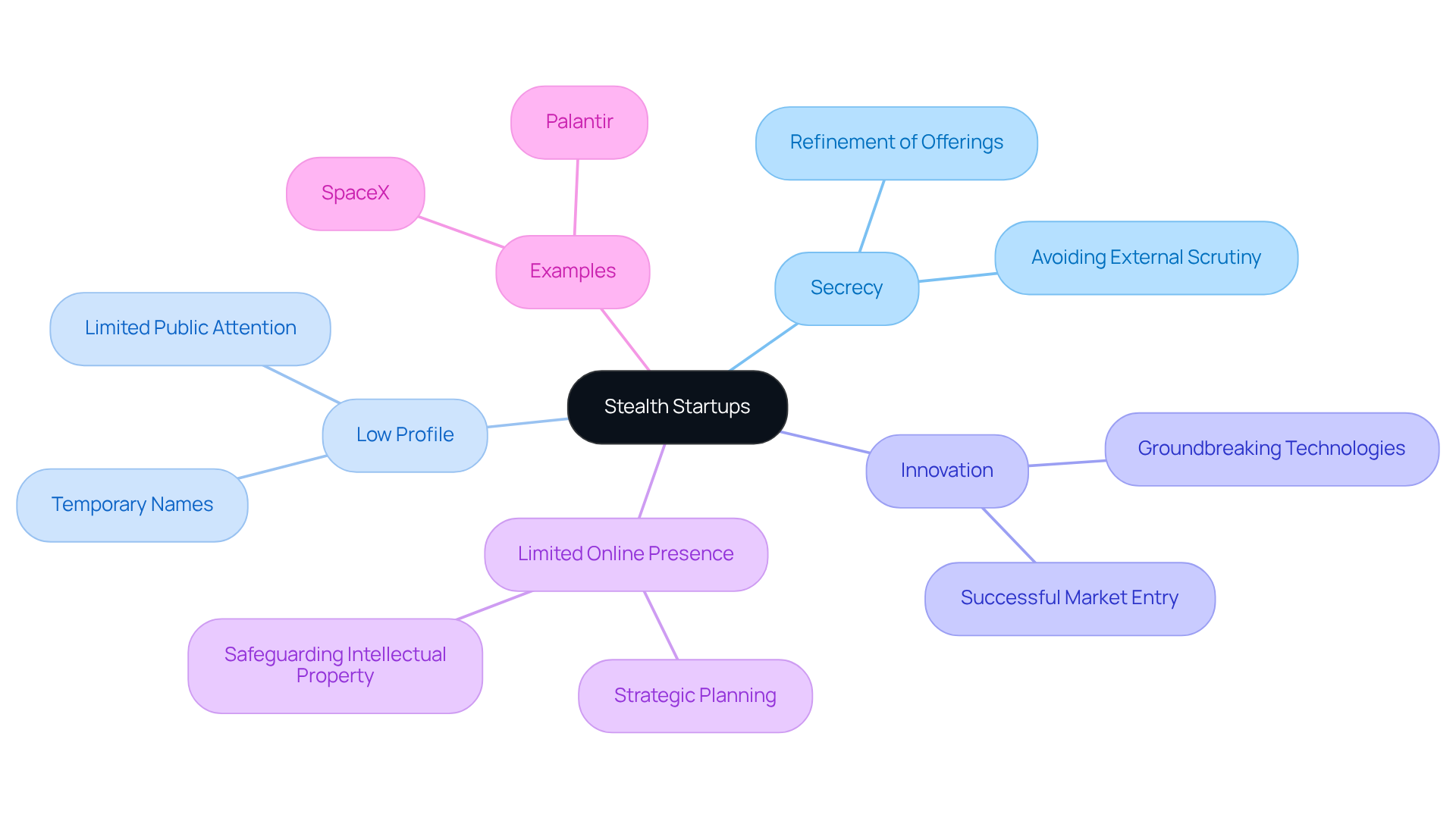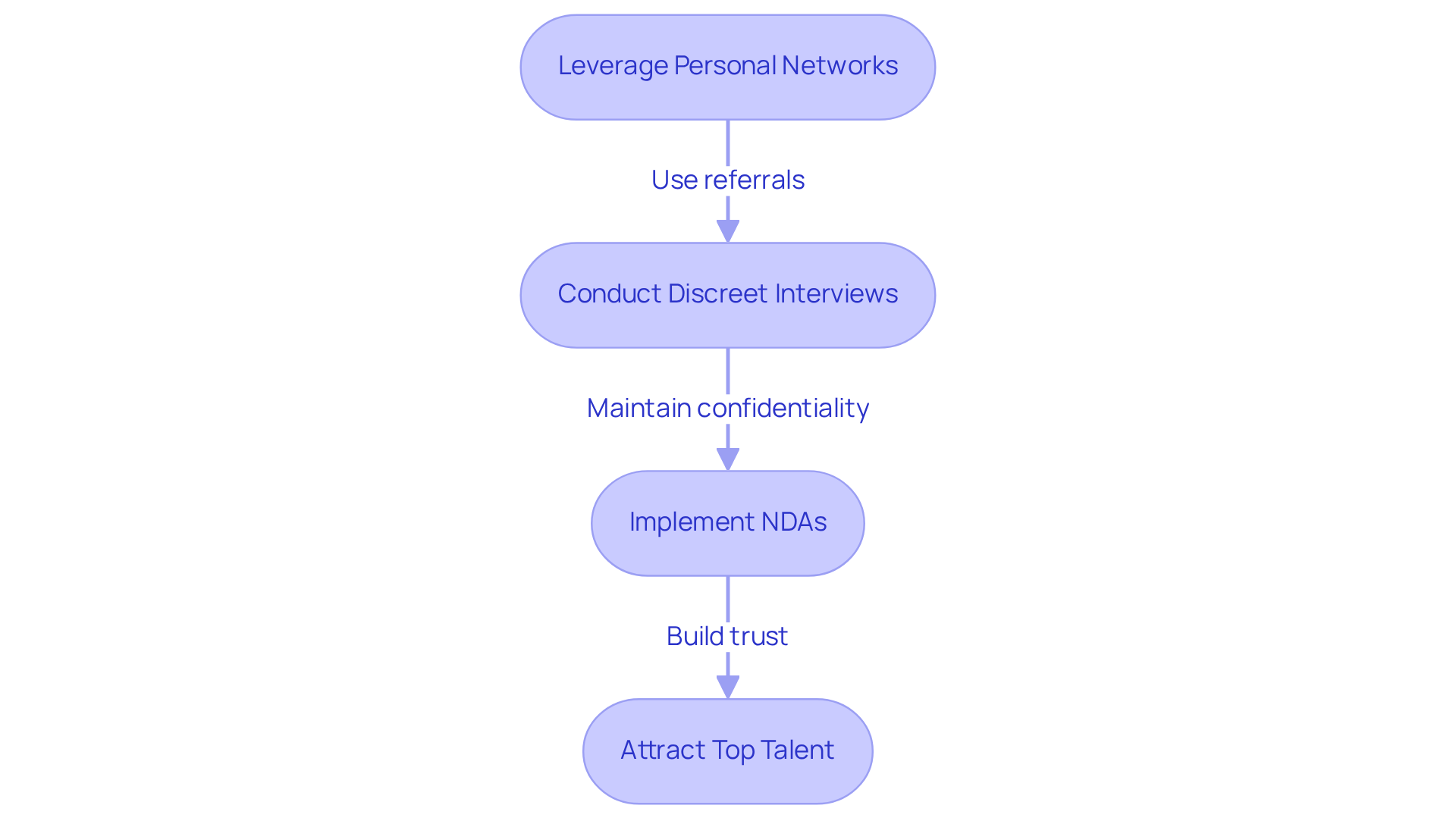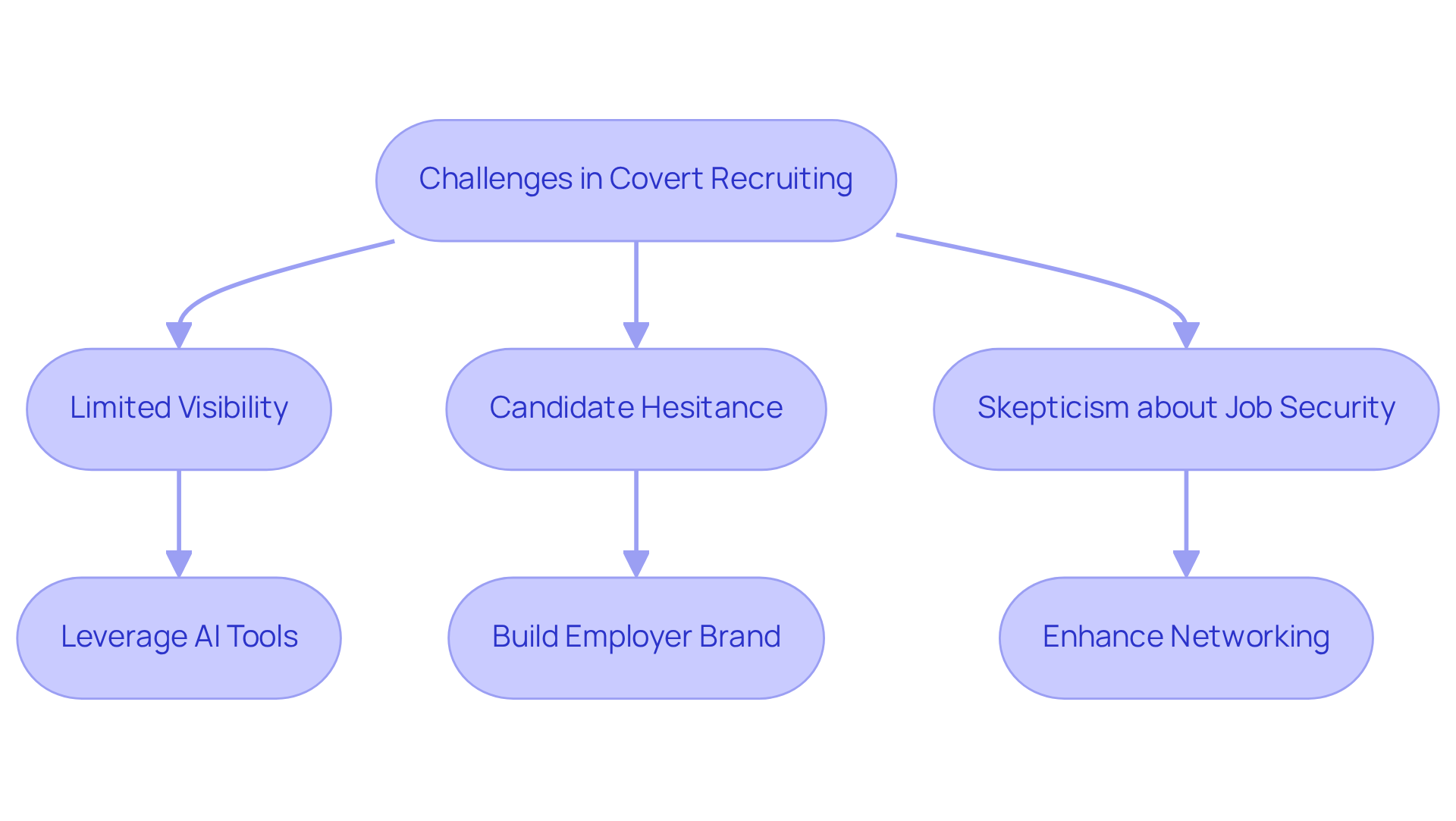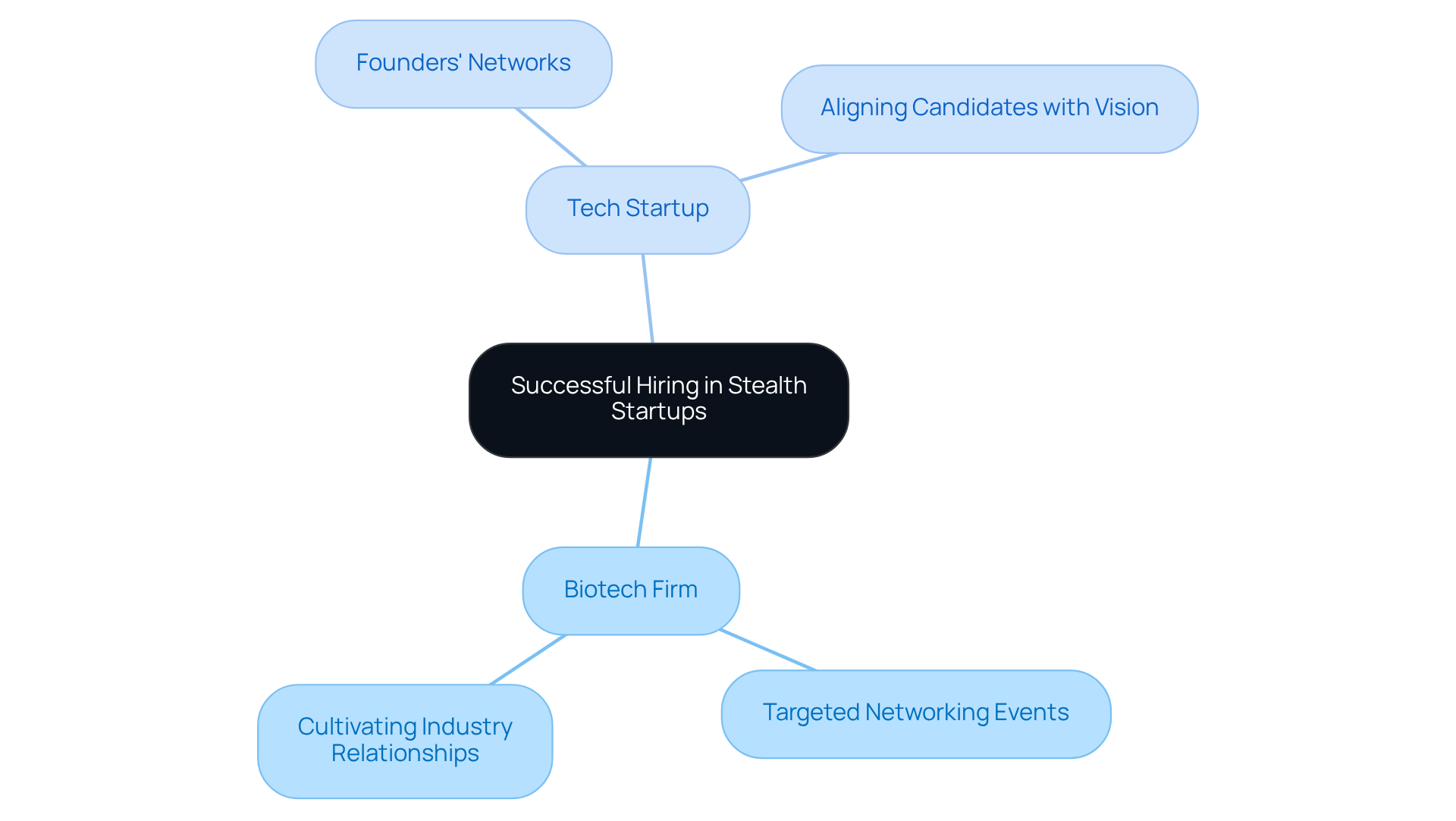Overview
Stealth startups implement distinctive hiring patterns that prioritize confidentiality and trust. By leveraging personal networks and referrals, they recruit talent while safeguarding sensitive operational details. These strategies—such as the implementation of non-disclosure agreements and targeted networking—are crucial for overcoming the challenges associated with attracting top candidates. Ultimately, they help maintain a competitive edge in an environment where secrecy is paramount.
Introduction
Stealth startups thrive in a realm of secrecy, crafting innovative solutions away from the public eye. This strategic approach not only nurtures creativity but also demands a recruitment strategy that prioritizes confidentiality and trust. Yet, the challenge is significant: attracting top talent in an environment where visibility is limited and skepticism prevails.
How can these covert companies navigate the complexities of hiring while preserving their competitive edge? This question invites a deeper exploration of the tactics that can empower stealth startups to succeed.
Define Stealth Startups: Characteristics and Purpose
A covert business operates in secrecy, often eluding public attention while developing its products or services. This enables such organizations to refine their offerings without external scrutiny or competition. Stealth startups typically maintain a low profile, utilizing temporary names and a limited online presence to safeguard their intellectual property and strategic plans. The primary goal of this concealed operation is to innovate and prepare for a successful market entry, free from the pressures of public expectations or premature competition. Notable examples include firms like Palantir and SpaceX, which embarked on their journeys in secrecy to develop groundbreaking technologies away from public view.

Examine Hiring Patterns: Recruitment Strategies in Stealth Mode
The hiring patterns in stealth startups require a meticulously crafted strategy that emphasizes confidentiality and trust. Stealth companies often leverage personal networks and referrals to pinpoint potential candidates, reflecting the hiring patterns in stealth startups, as traditional job postings may inadvertently reveal sensitive operational details.
For instance, Websets delivers precision-driven B2B lead generation and recruitment solutions, adept at identifying candidates who meet hyper-specific criteria, including those possessing elusive qualities. Interviews frequently occur without disclosing the company's identity, ensuring that the focus remains on the candidate's skills and cultural fit.
Additionally, the implementation of non-disclosure agreements (NDAs) during the recruitment process is commonplace, protecting proprietary information while cultivating a culture of trust among prospective hires. This approach is vital for fostering loyalty and dedication in high-pressure environments, where risks are particularly pronounced for both the new business and its employees.
As hiring patterns in stealth startups evolve in 2025, discreet new businesses must recalibrate their strategies to effectively attract top talent while safeguarding their competitive edge. A notable example is Proprio Vision, which successfully secured $7 million in funding while maintaining discretion. This illustrates how efficient hiring methods, supported by from Websets, can bolster a startup's success despite the challenges of operating under the radar.

Identify Challenges: Navigating Recruitment in Secrecy
Recruiting in a covert manner poses significant challenges. Limited visibility in the job market and difficulties in attracting top talent are primary concerns related to hiring patterns in stealth startups. Candidates often hesitate to join organizations they know little about, which impacts the hiring patterns in stealth startups and results in a diminished talent pool. Moreover, discreet businesses frequently face skepticism from prospective employees regarding job security and organizational stability, partly due to the hiring patterns in stealth startups.
To address these challenges, discreet companies can leverage Websets' . These tools enhance visibility and streamline the hiring process. Solutions such as the News Monitor, Hallucination Detector, Writing Assistant, and Company Researcher enable companies to effectively convey their vision and the unique opportunities they present, even while keeping specific operational details under wraps.
Building a robust employer brand is essential. Networking and word-of-mouth, bolstered by Websets' data analysis capabilities, can mitigate these issues. Trusted referrals enhance credibility and attract high-quality candidates. By implementing these strategies, companies can not only overcome the inherent challenges of covert recruiting but also align with the hiring patterns in stealth startups, positioning themselves as desirable employers in a competitive landscape.

Explore Case Studies: Successful Hiring in Stealth Startups
Stealth companies are skilled at navigating the hiring patterns in stealth startups through innovative strategies. For instance, a stealth-mode biotech firm effectively leveraged targeted networking events to connect with industry professionals, cultivating relationships that resulted in successful hires. Similarly, a tech startup discreetly tapped into its founders' existing networks to recruit top talent, ensuring candidates were not only skilled but also aligned with the organization’s vision.
These case studies illustrate that while hiring patterns in stealth startups present challenges, it is indeed possible to assemble a strong team through , trust-building, and a clear articulation of the company's mission and values.

Conclusion
Stealth startups thrive in a realm of secrecy, enabling them to innovate and develop products free from the pressures of public scrutiny and competition. This strategic approach not only protects their intellectual property but also fosters a unique environment conducive to growth and development. To attract top talent while preserving the confidentiality that characterizes their operations, it is essential to understand the hiring patterns specific to these covert businesses.
The article outlines several key strategies that stealth startups employ in their recruitment processes. By emphasizing personal networks and referrals, these companies can identify candidates who align with their vision without disclosing sensitive information. Furthermore, the implementation of non-disclosure agreements cultivates trust and loyalty among employees—an essential factor in high-stakes environments. The challenges posed by limited visibility and skepticism from potential hires are tackled through innovative tools and strategic networking, demonstrating how stealth startups can adeptly navigate the complexities of covert recruitment.
In light of these insights, it is evident that the success of stealth startups depends not only on their innovative products but also on their capacity to build a strong employer brand and effective hiring practices. As the landscape of stealth startups continues to evolve, embracing advanced recruitment strategies and fostering a culture of trust will be paramount. By prioritizing these elements, stealth startups can position themselves as attractive employers, ensuring they secure the talent necessary to thrive in a competitive market.
Frequently Asked Questions
What is a stealth startup?
A stealth startup is a covert business that operates in secrecy, often avoiding public attention while developing its products or services.
Why do stealth startups operate in secrecy?
Stealth startups operate in secrecy to refine their offerings without external scrutiny or competition, allowing them to innovate and prepare for a successful market entry.
How do stealth startups maintain a low profile?
They maintain a low profile by using temporary names and having a limited online presence to protect their intellectual property and strategic plans.
What is the primary goal of a stealth startup?
The primary goal of a stealth startup is to innovate and prepare for market entry without the pressures of public expectations or premature competition.
Can you provide examples of notable stealth startups?
Notable examples of stealth startups include firms like Palantir and SpaceX, which developed groundbreaking technologies away from public view.




